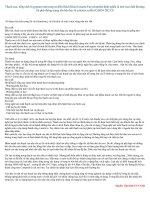- Trang chủ >>
- Khoa Học Tự Nhiên >>
- Vật lý
Tài liệu Chapter XXIV Crystalline Solids doc
Bạn đang xem bản rút gọn của tài liệu. Xem và tải ngay bản đầy đủ của tài liệu tại đây (388.02 KB, 21 trang )
GENERAL PHYSICS III
GENERAL PHYSICS III
Optics
&
Quantum Physics
Chapter XXIV
Chapter XXIV
Crystalline Solids
Crystalline Solids
§1. Wavefunctions and energy band of electrons
§2. Electronic conduction in metals
§3. Semiconductors
To have a quantum-mechanical treatment we model a crystalline solid as
matter in which the atoms have long-range order, that is a recurring
(periodical) pattern of atomic positions that extends over many atoms.
We will describe the wavefunctions and energy levels of electrons in
such periodical atomic structures.
We want to answer the question: Why do some solids conduct currWe want to answer the question: Why do some solids conduct currentent
and others donand others don’’t?t?
§1. Wavefunctions and energy band of electrons:
1.1 Potential energy of electrons:
+e
r
n = 3
n = 2
n = 1
+e
r
+e
r
e
)r(U
2
2
2
1
2
rr
e
rr
e
)r(U
Atom H
Two atoms (molecule H
2
)
+e
r
n = 3
n = 2
n = 1
Atom Solid
Discrete atomic states band of crystal states Fill according to Pauli Principle
• A simple (1-D) model of the recurring structure is shown below.
• An electron interacts not with one, but with many nuclei every
energy level splits into a band of energies
1.2 Wavefunctions
1.2 Wavefunctions
and
and
Energies:
Energies:
• Atomic ground state:
• Molecular states:
+e
r
n = 1
A
Bonding state Antibonding state
r
e
)r(U
2
0
a/r
e)r(
Now we fill these orbitals with the 2 available electrons (one from
each hydrogen atom). Both can go into ‘bonding’, thanks to spin
+e
r
+e
even
+e
r
+e
odd
What do these crystal states look like?
-- approximately linear combinations of atomic orbitals.
Again start with
simple atomic state:
+e
r
n = 1
A
Bring N atoms together together forming a 1-D crystal (a periodic lattice)
(N atomic states N crystal states):
Energy
band
• 1-D periodic lattice:
•• SimpleSimple model of a crystalmodel of a crystal withwith covalentcovalent bonding:bonding:
N
Highest energy orbital (N-1 nodes)
1
Lowest energy orbital (zero nodes)
“in between” states









